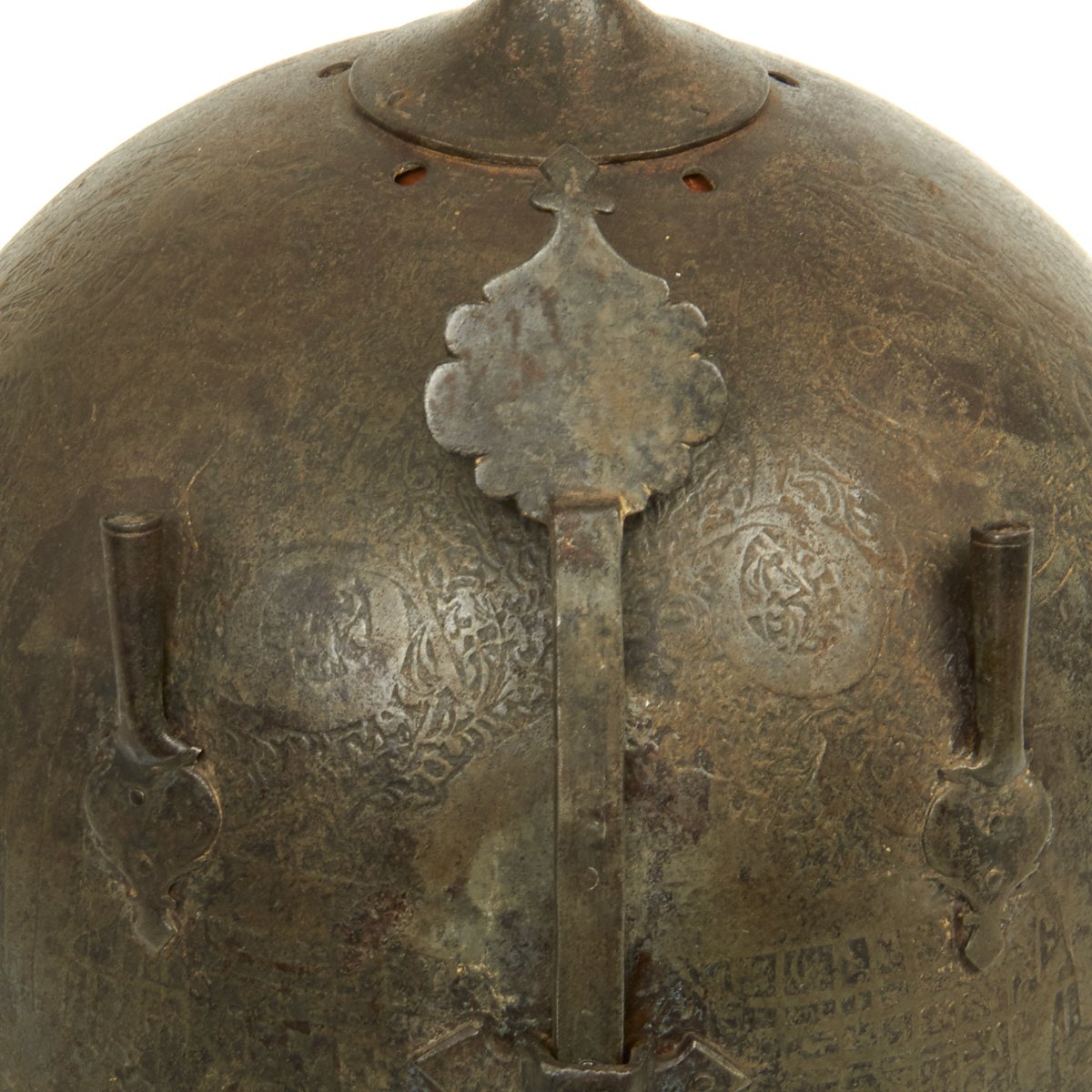Original 18th/19th Century Persian Kulah Khud Spiked War Helmet circa 1780-1820 Original Items
$ 995,00 $ 248,75
Original Item: Only One Available. We’ve all seen the Indo-Persian KULAH KHUD spiked helmets of the 18th and 19th centuries. This design goes back to the times of the Crusaders and Saladin during the battles over the Holy Land in the 13th and 14th centuries.
Our helmet is etched and chiseled steel covered in oriental designs behind a sliding nasal bar. The circular bowl shaped helmet is fully surrounded with a chain mail coif leaving an opening for the face. In addition to the Spike to the top there are two plume holders, one on each side.
In fine neglected condition having recently been discovered in an English attic where it has lain for perhaps 150 years, the war trophy of some Officers who took part in Queen Victoria’s Colonial Campaigns.
Comes with wooden stand. Ready to display.
History of the Kulah Khud Helmet:
Kulah Khuds (known as top in India and Devil mask among English speaking arms collectors) were used in ancient western Asia for battle and as decorative head pieces. This style of helmet originated in Central Asia, and were worn by [Persian Empire] soldiers in the 18th and 19th Centuries. Made of steel, these bowl-shaped helmets were designed as either low and flat, or high and pointed. They sometimes contained a spike socket at the top of the helmet, which resembles a spearhead with a cross-like section. Two or three plume holders were attached on either side of the skull, used to mount feathers from birds such as the egret.
The helmet had an iron-and-brass or brass-and-copper male aventail that hung at the base of the helmet to protect the neck, shoulders and the temple of the face. Sometimes, the male aventail extended down to cover the eyes and the nose. The low end of the male aventail was often shaped in a triangular pattern so they stood relatively affixed on the front and back side of the warrior’s shoulder.
A bar made of iron or steel was attached to the front of the helmet with a bracket and could be adjusted in position – so when not in use, it could slide upward and fasten with a link, a hook, or a set screw. The two ends of the bar expanded into leaf-shaped plates, forming a final. In some Indian tops, the lower end of the bar was designed as a large crescent-shaped metal guard that protected most of the face below the eye level. One rare version of the helmet included three irons protecting the nose and the cheeks
Fast Shipping with Professional Packaging
Thanks to our longstanding association with UPS FedEx DHL, and other major international carriers, we are able to provide a range of shipping options. Our warehouse staff is expertly trained and will wrap your products according to our exact and precise specifications. Prior to shipping, your goods will be thoroughly examined and securely secured. We ship to thousands clients each day across multiple countries. This shows how we're dedicated to be the largest retailer on the internet. Warehouses and distribution centres can be located throughout Europe as well as the USA.
Note: Orders with more than one item will be assigned a processing date depending on the item.
Before shipping before shipping, we'll conduct a thorough inspection of the items you have ordered. Today, the majority of orders will be delivered within 48 hours. The delivery time will be between 3-7 days.
Returns
The stock is dynamic and we cannot completely manage it because multiple stakeholders are involved, including our factory and warehouse. So the actual stock may alter at any time. It's possible that you may not receive your order once the order has been made.
Our policy is valid for a period of 30 days. If you don't receive the product within 30 days, we are not able to issue a refund or an exchange.
You can only return an item if it is unused and in the same state as the day you received it. You must have the item in its original packaging.
Related products
Uncategorized
Uncategorized
Uncategorized
Uncategorized
Armored Burgonet Helmet & Polearm from Scottish Castle Leith Hall Circa 1700 Original Items
Uncategorized
Uncategorized
Uncategorized
Uncategorized
Uncategorized
Uncategorized
Angolan Rebel 1970s era 60mm Inert Display Mortar from Angolan Civil War Original Items
Uncategorized
Uncategorized
Uncategorized
Uncategorized
Uncategorized
Uncategorized
Uncategorized
Armoured Fighting Vehicles of the World: AFVs of World War One (Hardcover Book) New Made Items
Uncategorized
Australian WWII Owen MK1 Machine Carbine SMG Custom Fabricated Replica with Sling Original Items












































































